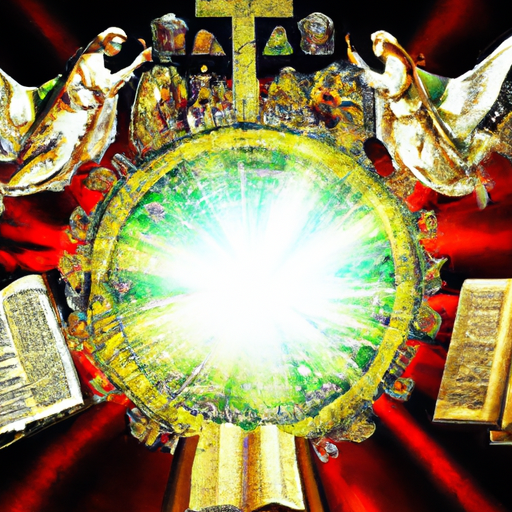In this captivating article, you will embark on a journey to unravel the mysterious and intriguing passages of the book of Revelation. Focusing specifically on Revelation 5:5, you will delve into the meaning behind the unveiling of the seven seals. Discover the profound significance and symbolism hidden within these ancient texts, as you gain a deeper understanding of this impactful biblical narrative. Get ready to unlock the secrets of the seven seals and gain insights into the profound messages they hold for humanity.
Introduction
Welcome to this comprehensive article on the Book of Revelation and specifically the unveiling of the Seven Seals. In this article, we will delve into the background, structure, and symbolism of the Book of Revelation, with a particular focus on Revelation 5:5. Get ready to uncover the mysteries and gain a deeper understanding of this captivating biblical text.
Background of the Book of Revelation
Authorship
The Book of Revelation, also known as the Apocalypse of John, is traditionally attributed to the Apostle John. However, there is some debate among scholars regarding the authorship. Some argue that it may have been written by a different John or a group of authors, given the distinct style and theological differences in comparison to John’s other works. Regardless of the authorship, the book holds significant importance in Christian theology and eschatology.
Date and Context
The Book of Revelation is believed to have been written sometime around 95 AD during the reign of the Roman Emperor Domitian. At this time, Christians were facing persecution, and John himself was believed to have been exiled to the island of Patmos. The context of intense persecution and political turmoil sets the stage for the apocalyptic and prophetic nature of the book.
Purpose and Audience
Revelation is considered a form of apocalyptic literature, with its purpose being to address the immediate concerns of the early Christian community and provide them with hope and encouragement in the face of persecution. The audience of the book was likely a group of seven churches in Asia Minor, who were facing various challenges and needed spiritual guidance and reassurance.

Overview of the Book of Revelation
Apocalyptic Literature
The Book of Revelation belongs to the genre of apocalyptic literature, which is characterized by its vivid imagery, symbolic language, and prophetic visions. This genre often arises during times of crisis or persecution, serving to warn, comfort, and inspire the faithful. Understanding the apocalyptic nature of Revelation is essential for interpreting its content.
Structure and Themes
Revelation is divided into three major sections: the letters to the seven churches, the visions and prophecies, and the conclusion. The book is replete with vivid imagery, numerological symbolism, and references to Old Testament prophecies. Themes of judgment, salvation, spiritual warfare, and the ultimate victory of God are interwoven throughout the text, providing a cohesive and captivating narrative.
Understanding the Seven Seals
The Meaning of Seals in Ancient Times
In ancient times, seals held significant importance, particularly in the context of legal agreements, document authentication, and securing items of value. Seals were used to grant authority, authenticate ownership, and ensure the integrity of a document or object. Understanding the cultural significance of seals helps shed light on the symbolism behind the Seven Seals in Revelation.
The Number Seven in the Bible
The number seven holds great symbolic value in the Bible, representing completion, perfection, and divine order. Throughout the Book of Revelation, the number seven appears repeatedly, indicating the completeness of God’s plan and the unfolding of His divine purposes. The Seven Seals represent a crucial part of this divine plan, unveiling significant events and revealing the ultimate triumph of God.
Symbolism of the Seals in Revelation
The symbolism behind the Seven Seals is multifaceted and rich in meaning. Each seal represents a specific event or judgment that contributes to the overall narrative of Revelation. From war and famine to death and destruction, the seals showcase both the imminent trials faced by believers and the ultimate victory that awaits them. They serve as a reminder of the temporary nature of suffering and the redemptive power of God.

The Lamb Who is Worthy – Revelation 5:5
Introduction to Revelation 5:5
Revelation 5:5 is a pivotal verse in the Book of Revelation, introducing the central figure known as the Lamb who is found worthy to open the Scroll. This verse sets the stage for understanding the role and significance of the Lamb in the unfolding of the divine plan.
The Lamb’s Identity
The Lamb in Revelation 5:5 is a symbolic representation of Jesus Christ, the sacrificial lamb of God who takes away the sins of the world. This imagery draws upon Old Testament references to the Passover lamb and the suffering servant in Isaiah. The identification of Jesus as the Lamb underscores His sacrificial role in redemption and emphasizes His authority and worthiness to carry out God’s plan.
The Importance of the Lamb in Revelation
The Lamb plays a vital role throughout the Book of Revelation, functioning as the central figure of worship, the guide through visions and prophecies, and the conqueror who ultimately triumphs over evil. The Lamb’s sacrifice and victory over death provide hope and assurance to believers that, despite the trials and tribulations they may face, they can find strength and salvation in Jesus Christ.
The Sealed Scroll – Revelation 5:1
The Scroll as a Symbol
The Sealed Scroll mentioned in Revelation 5:1 represents the divine plan of God and contains the judgments and events that will occur throughout human history. The scroll is sealed with seven seals, indicating its completeness and secrecy. This scroll becomes a focal point of anticipation and reveals the unfolding of God’s purpose for humanity.
The Significance of the Scroll’s Seals
The seven seals on the Scroll represent the sequential breaking and revealing of various events and judgments, each contributing to the fulfillment of God’s plan. As each seal is opened, new aspects of God’s redemptive work are unveiled, leading to the ultimate victory of good over evil. The seals serve as a means of progression, highlighting the divine order and the significance of each unfolding event.
The Search for the One Worthy to Open the Scroll
In Revelation 5, the search for someone worthy to open the Scroll leads to a moment of tension and anticipation. The question of who is worthy to break the seals and reveal the divine plan poses a challenge to the entire creation. This search underscores the need for a worthy and authoritative figure who can carry out God’s purposes and bring about the ultimate triumph of righteousness.
The Lion and the Lamb – Revelation 5:5-6
The Lion of the Tribe of Judah
Revelation 5:5-6 describes the Lion of the Tribe of Judah, a title attributed to Jesus. The image of a lion evokes power, strength, and authority, symbolizing the majestic nature of Christ. This depiction of Jesus as the Lion acknowledges His kingship and His ability to conquer and overcome all obstacles.
The Root of David
The title “The Root of David” further emphasizes Jesus’ messianic role and connection to the lineage of King David. Jesus is the fulfillment of the messianic prophecies and the rightful heir to David’s throne. This title highlights His authority and establishes His divine right to rule and judge.
The Lamb’s Sacrificial Role
The juxtaposition of the Lion and the Lamb in Revelation 5:5-6 is significant. While Jesus is depicted as a powerful and majestic Lion, He is also referred to as a Lamb, pointing to His sacrificial role in redemption. The Lamb’s sacrifice and subsequent victory over sin and death provide hope and salvation to all who believe in Him.
The Triumph of the Lamb – Revelation 5:9-10
The Lamb’s Redemption of Humanity
Revelation 5:9-10 depicts the Lamb’s redemptive work by highlighting His sacrifice as the means by which humanity is reconciled to God. The Lamb’s shed blood, symbolizing His sacrificial death, becomes the basis for the redemption of people from every tribe, language, and nation. This universal redemption demonstrates the inclusivity and transformative power of the Lamb’s work.
The Multitude of the Redeemed
The imagery of the multitude of the redeemed in Revelation 5:9-10 signifies the global impact of the Lamb’s redemptive work. The diversity and vastness of the redeemed emphasize the universal nature of salvation, highlighting the Lamb’s victory over sin and its power to unite people from all walks of life.
The Lamb’s Role in Salvation History
The Lamb’s role in salvation history is foundational to Christian beliefs and eschatology. The Lamb’s sacrifice serves as the ultimate act of love and atonement, offering forgiveness and redemption to all who believe. The Lamb’s victory over sin and death paves the way for the establishment of God’s kingdom, where righteousness and peace will ultimately prevail.
Conclusion
In conclusion, the unveiling of the Seven Seals in the Book of Revelation provides a captivating and profound glimpse into God’s plan for humanity. The symbolism of the seals, the identity and significance of the Lamb, and the ultimate triumph of righteousness are central themes of this powerful biblical text.
The Book of Revelation, with its apocalyptic literature and prophetic visions, offers hope and encouragement to believers facing trials and persecution. It reveals the divine order and purposes behind human history, reminding us of the temporary nature of suffering and the ultimate victory found in Jesus Christ.
As we explore the unveiling of the Seven Seals, we gain a deeper understanding of God’s redemptive work and its implications for our lives. The Lamb who is worthy, the sealed scroll, and the triumph of the Lamb all point to the incredible love, mercy, and power of God.
May this article serve as a guide to decipher the rich symbolism and meaning behind the Book of Revelation, inspiring you to embrace the hope and assurance found in the Lamb who is worthy.







